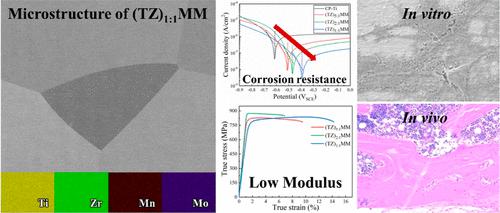当前位置:
X-MOL 学术
›
ACS Biomater. Sci. Eng.
›
论文详情
Our official English website, www.x-mol.net, welcomes your
feedback! (Note: you will need to create a separate account there.)
Effects of Zr Addition on the Microstructural Evolution, Mechanical Properties, and Corrosion Behavior of Novel Biomedical Ti–Zr–Mo–Mn Alloys
ACS Biomaterials Science & Engineering ( IF 5.4 ) Pub Date : 2023-11-08 , DOI: 10.1021/acsbiomaterials.3c01012 Zheng Li 1 , Jin Wo 2 , Yuanyue Fu 2 , Xincheng Xu 1 , Binbin Wang 1 , Hui Liu 1, 3 , Deqiang You 1 , Guodong Sun 2, 4 , Wei Li 1 , Xiaojian Wang 1, 5, 6
ACS Biomaterials Science & Engineering ( IF 5.4 ) Pub Date : 2023-11-08 , DOI: 10.1021/acsbiomaterials.3c01012 Zheng Li 1 , Jin Wo 2 , Yuanyue Fu 2 , Xincheng Xu 1 , Binbin Wang 1 , Hui Liu 1, 3 , Deqiang You 1 , Guodong Sun 2, 4 , Wei Li 1 , Xiaojian Wang 1, 5, 6
Affiliation

|
β-Type Ti alloys have been widely investigated as implant materials owing to their excellent mechanical properties, corrosion resistance, and biocompatibility. In the present work, the effects of Zr on the microstructure, mechanical properties, and corrosion behaviors of Ti–Zr–Mo–Mn alloys were systematically studied. With the increase of Zr content, the phase composition gradually changed from intragranular-α + β of (TZ)5:1MM alloy to grain-boundary-α + β of (TZ)2:1MM alloy and finally transferred to a single β phase structure of (TZ)1:1MM alloy. The (TZ)1:1MM alloy exhibited a good mechanical combination with a yield strength of 750.8 MPa, an elastic modulus of 61.3 GPa, and a tensile ductility of 14.6%. Moreover, the addition of Zr can effectively stabilize the passivation film and reduce the sensitivity of microgalvanic corrosion in simulated body fluid, leading to enhanced corrosion resistance in the TZMM alloys. X-ray photoelectron spectroscopy analysis together with the ion-sputtering technique revealed that the passivation films formed on TZMM alloys possessed a bilayered structure (outer Ti+Zr mixed-oxide layer and inner Zr-oxide-rich layer), in which the inner Zr oxide layer plays an important role in the corrosion resistance of the TZMM alloys. In vitro biocompatibility evaluations demonstrated that the TZMM alloys can support cell adhesion and proliferation with high biocompatibility comparable to that of CP-Ti, while in vivo biocompatibility evaluations validated the bone osteointegration ability of TZMM alloys after long-term implantation. The above results indicate that novel TZMM alloys are promising candidates for implant material.
中文翻译:

Zr 添加对新型生物医用 Ti-Zr-Mo-Mn 合金显微组织演变、力学性能和腐蚀行为的影响
β型钛合金因其优异的机械性能、耐腐蚀性和生物相容性而作为植入材料被广泛研究。本工作系统研究了Zr对Ti-Zr-Mo-Mn合金显微组织、力学性能和腐蚀行为的影响。随着Zr含量的增加,相组成逐渐从(TZ) 5: 1MM合金的晶内-α+β转变为(TZ) 2: 1MM合金的晶界-α+β,最后转变为单一相。 (TZ) 1: 1MM合金的β相结构。 (TZ) 1:1 MM合金表现出良好的机械组合,屈服强度为750.8 MPa,弹性模量为61.3 GPa,拉伸塑性为14.6%。此外,Zr的添加可以有效稳定钝化膜,降低模拟体液中微电偶腐蚀的敏感性,从而增强TZMM合金的耐腐蚀性能。 X射线光电子能谱分析和离子溅射技术表明,TZMM合金上形成的钝化膜具有双层结构(外层Ti+Zr混合氧化物层和内层富Zr氧化物层),其中内层Zr氧化层对于TZMM合金的耐腐蚀性能起着重要作用。体外生物相容性评估表明,TZMM合金可以支持细胞粘附和增殖,具有与CP-Ti相当的高生物相容性,而体内生物相容性评估则验证了TZMM合金长期植入后的骨整合能力。上述结果表明新型 TZMM 合金是有前途的植入材料候选者。
更新日期:2023-11-08
中文翻译:

Zr 添加对新型生物医用 Ti-Zr-Mo-Mn 合金显微组织演变、力学性能和腐蚀行为的影响
β型钛合金因其优异的机械性能、耐腐蚀性和生物相容性而作为植入材料被广泛研究。本工作系统研究了Zr对Ti-Zr-Mo-Mn合金显微组织、力学性能和腐蚀行为的影响。随着Zr含量的增加,相组成逐渐从(TZ) 5: 1MM合金的晶内-α+β转变为(TZ) 2: 1MM合金的晶界-α+β,最后转变为单一相。 (TZ) 1: 1MM合金的β相结构。 (TZ) 1:1 MM合金表现出良好的机械组合,屈服强度为750.8 MPa,弹性模量为61.3 GPa,拉伸塑性为14.6%。此外,Zr的添加可以有效稳定钝化膜,降低模拟体液中微电偶腐蚀的敏感性,从而增强TZMM合金的耐腐蚀性能。 X射线光电子能谱分析和离子溅射技术表明,TZMM合金上形成的钝化膜具有双层结构(外层Ti+Zr混合氧化物层和内层富Zr氧化物层),其中内层Zr氧化层对于TZMM合金的耐腐蚀性能起着重要作用。体外生物相容性评估表明,TZMM合金可以支持细胞粘附和增殖,具有与CP-Ti相当的高生物相容性,而体内生物相容性评估则验证了TZMM合金长期植入后的骨整合能力。上述结果表明新型 TZMM 合金是有前途的植入材料候选者。













































 京公网安备 11010802027423号
京公网安备 11010802027423号